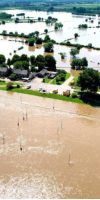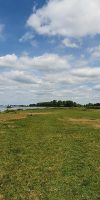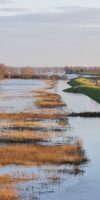Filter by:
News
Stay informed of all the latest Deltares developments in the field of water and subsurface.
-
Trees excellent at attenuating waves: first scientific evidence now available
A lot of claims are made worldwide about how nature – such as willow trees or mangroves – can help to provide protection against flooding, typhoons and tsunamis. Until now, however, there have been few studies looking at how natural systems behave in extreme conditions like super storms. How well do trees break waves, and can they cope? A paper published this week in Scientific Reports by scientists from Deltares, the Netherlands Institute for Marine Research (NIOZ) and Delft University of Technology, provides the first evidence about how we can best use trees for flood risk management. -
What can COVID-19 teach us about preparing for climate risks in Europe?
High-impact and global crises like the current pandemic reveal our preparedness for disasters. COVID-19 has shown how difficult it can be to effectively respond to severe unprecedented disruptions. As our economies are struggling to adapt to the new normal, researchers are examining how we can learn from this systemic shock to increase societies’ resilience to future pandemics as well as worldwide disruptions, such as the climate crisis. RECEIPT, a H2020 project led by Deltares, is using novel scientific methods to foster preparedness. -
New edition of Deltalife: effects of climate change
Our latest edition of our corporate magazine 'Deltalife' just came out. Climate change is the challenging context for our knowledge, system analyses and the exploration of action perspectives for integrated water management. 
Seven recommendations in response to the floods of July 2021
What if the extremely heavy rain in July 2021, with devastating consequences in Limburg, Belgium and Germany, had fallen elsewhere in the Netherlands? Deltares researchers studied this question recently in a three-day hackathon. The conclusion is that flooding cannot be prevented when there are such large-scale and extreme precipitation events. Nevertheless, with more resilient spatial planning and better preparation, the Netherlands can stop the disruption turning into a disaster.
Design guideline for aquathermal systems bundles knowledge and experience
To make a better assessment beforehand of important considerations in aquathermal systems, and the risks, experts have developed a design guideline. Aquathermal systems are increasingly being used to heat buildings. They harvest thermal energy from surface water (TEO) and therefore use the water as a sustainable energy source. With the guideline, designers, managers and installation engineers can design reliable and efficient aquathermal systems for now and the long term.-
Fresh groundwater under the sea: a potential source of water?
There are large volumes of fresh groundwater below the seafloor in many coastal areas around the world. They could perhaps be used as a temporary source of water in water-stressed coastal regions. 
Impact of high water in Limburg summer 2021
High water in Limburg in the summer of 2021 had more impact than river floods in 1993 and 1995. The intense rainfall and high water of July 2021 in the Netherlands and the neighbouring countries was an extreme and exceptional event with a major social impact in Limburg. On behalf of the Expertise Network on Flood Risk Management (ENW), a broad consortium of research institutions led by Delft University of Technology and Deltares has now completed an initial analysis of the available information on a range of subjects.
Nature-based Solutions as cost-effective method to drive climate change adaptation
With Germany, Belgium and Turkey still reeling from historic floods, a new report outlines how Nature-based Solutions can help reduce the impact of such disasters across Europe.-
50% of Mekong Delta at risk of salinisation due to sand mining and dam building
Sediment starvation in the Mekong Delta can drive 50% of the area saline by 2050. This is shown in a study by the Rise and Fall Project of Utrecht University and Deltares, published in the Springer Nature journal Communications Earth and Environment. The researchers show that in the first half of the century, the anthropogenic forces, specifically eroding riverbeds due to sediment starvation, can have a 6-7 times larger impact on salt intrusion than climate change and sea level rise. -
New maps of foundation risk at neighbourhood level in the Climate Impact Atlas
Low groundwater levels caused by drought and land subsidence may result in damage to foundations. New maps in the Climate Impact Atlas now provide a clearer picture of the local risk of damage to wooden pile foundations (pile rot) and the differential settlement of buildings on steel foundations. -
Updated land subsidence maps show the effects of climate change and water level management
Nine million Dutch people live or work in areas where the land is subsiding. The extent of subsidence in the future depends mainly on the amount of gas and salt extraction, how much the climate warms up and on the water level policy in place. The new maps in the Climate Effect Atlas for forecasting land subsidence provide an insight into the extent of subsidence in the Netherlands until 2100. Water level policy - fixing the water level as opposed to indexing it - and climate change have been included in a high and a low scenario. 
Coastal retreat as a serious option to adapt to sea-level rise
Sea-level rise is expected to have severe consequences. To adapt to sea-level rise a range of options exists: protection, accommodation, coastal advance and retreat. So far, retreat has been mostly used post hoc, rather than preemptively. Researchers from Deltares, Utrecht University, New Zealand Climate Change Research Institute at Victoria University of Wellington, and Institute for Sustainable Development and International Relations demonstrate in the scientific journal Science how exploring pathways to managed retreat adds value in the context of the accelerating and long-term commitment to SLR. They argue that there is an urgent need to keep coastal retreat on the table as an option to adapt to sea-level rise.
